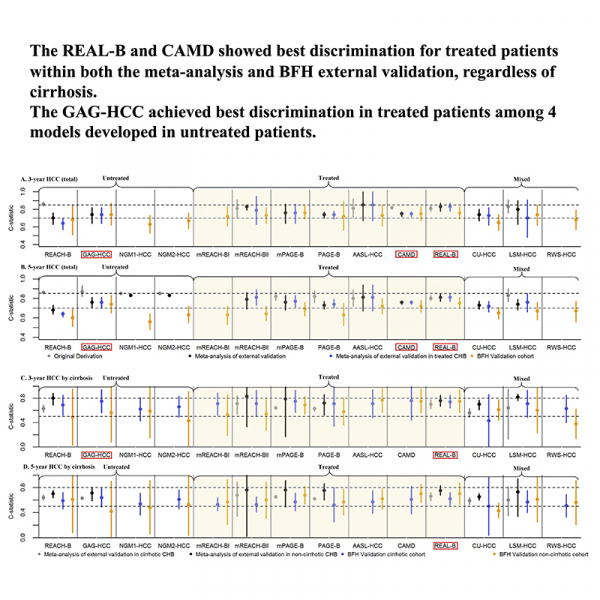In this study, we aim to characterize the performance of hepatocellular carcinoma (HCC) prediction models in chronic hepatitis B (CHB) patients through meta-analysis followed by external validation. We performed a systematic review and meta-analysis of current literature, followed by external validation in an independent multi-center cohort with 986 patients with CHB undergoing entecavir treatment (median follow-up: 4.7 years). Model performance to predict HCC within 3, 5, 7, and 10 years was assessed using the area under the receiver operating characteristic curve (AUROC) and calibration index. Subgroup analyses were conducted by treatment status, cirrhotic, race, and baseline alanine aminotransferase. We identified 14 models with 123,885 patients (5,452 HCC cases), with REACH-B, CU-HCC, GAG-HCC, PAGE-B and mPAGE-B models being broadly externally validated. Discrimination was generally acceptable for all models, with pooled AUC ranging from 0.70 (95% CI, 0.63-0.76 for REACH-B) to 0.83 (95% CI, 0.78-0.87 for REAL-B) for 3-year, 0.68 (95% CI, 0.64-0.73 for REACH-B) to 0.81 (95% CI, 0.77-0.85 for REAL-B) for 5-year and 0.70 (95% CI, 0.58-0.80 for PAGE-B) to 0.81 (95% CI, 0.78-0.84 for REAL-B and 0.77-0.86 for AASL-HCC) for 10-year prediction. However, calibration performance was poorly reported in most studies. In external validation cohort, REAL-B showed highest discrimination with 0.76 (95% CI, 0.69-0.83) and 0.75 (95% CI, 0.70-0.81) for 3 and 5-year prediction. The REAL-B model was also well-calibrated in the external validation cohort (3-year Brier score 0.066). Results were consistent in subgroup analyses. The REAL-B model exhibited the best discrimination and calibration in this systematic review of available HCC models.
Language
週三, 03 三月 2021 00:00
